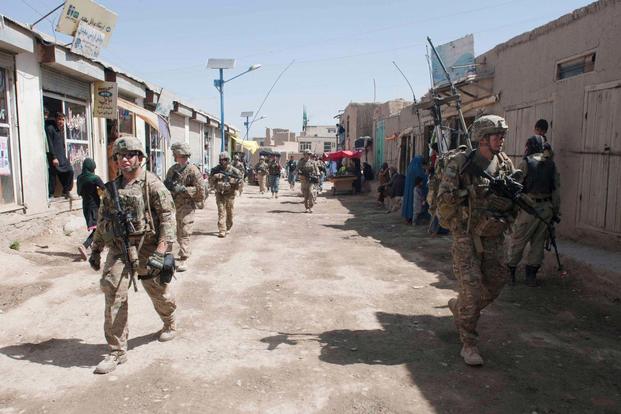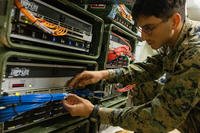President Donald Trump wants the Pentagon to come up with a new plan to win in Afghanistan before authorizing the deployment of thousands more U.S. troops to the 15-year-old war, White House Press Secretary Sean Spicer said Tuesday.
"We have nothing to share at this time" on whether Trump is close to deciding on troop levels in Afghanistan, Spicer said at the daily White House briefing.
Spicer said Trump "wants to make sure that we do what we can to win, and that's why he charged the generals and other military advisers and national security team to come up with a plan that can get us there."
Trump is also concerned about the untimely disclosing of U.S. plans, Spicer said. "I mean, he's talked about not projecting where he's going and what he's going to do to let the enemy know ahead of time."
As the U.S. weighs sending more troops to Afghanistan, Defense Secretary Jim Mattis said Tuesday that a stable and honest government in Kabul is the key to ending the Taliban insurgency.
"In Afghanistan, we're up against a determined enemy," Mattis told reporters accompanying him on a trip to Denmark for a meeting of the U.S.-led coalition against the Islamic State of Iraq and Syria, or ISIS.
"When the government wins the affection, the respect and the support of their people, then no enemy can stand against them," he said.
Trump is expected to make a decision on yet another U.S. troop surge in Afghanistan before attending a NATO summit in Brussels on May 25.
Taliban success in the north, the combat deaths of two Army Rangers in the southeast, renewed cross-border fighting with Pakistan, and a central government in disarray have lent urgency to the request by Army Gen. John Nicholson for thousands more U.S. troops to be sent to Afghanistan.
The U.S. currently has about 8,500 troops in Afghanistan, including about 300 Marines who returned to embattled southwestern Helmand province last month, and NATO has about 4,500.
All are commanded by Nicholson, commander of U.S. Forces Afghanistan and NATO's Resolute Support mission.
Nicholson told Congress in February that that the 15-year-old war against the Taliban was at a "stalemate" and he needed a "few thousand" more U.S. troops to work at lower levels with the more than 300,000 Afghan National Defense Security Forces in the train, advise and assist mission. His request was believed to be in the range of 3,000 to 5,000 additional troops.
The U.S. turned over the lead combat role to the Afghan forces in 2014 amid major troop withdrawals to reduce the U.S. military presence, which once exceeded 100,000 troops. In 2009. President Barack Obama ordered a troop surge of 30,000 troops to Afghanistan on an 18-month timetable for their withdrawal.
Mattis said the key to turning around the war in Afghanistan was shoring up the stability of the government of President Ashraf Ghani while accelerating a military campaign meant to drive the Taliban to peace negotiations. Ghani has struggled to root out endemic corruption and reportedly is barely on speaking terms with his chief executive, Abdullah Abdullah.
Mattis and Army Lt. Gen. H.R. McMaster, the White House National Security Adviser, went to Kabul separately last month to confer with Nicholson on the way forward. Their visits came days after Ghani sacked the Defense Minister and the army chief following a Taliban assault on a base of the Afghan army's 209th Corps outside Mazar-i-Sharif in northern Balkh province that killed at least 140 Afghan troops.
Mattis said then that he was still hopeful of a political settlement with the Taliban that could lead to peace. "If the Taliban want to join the political process and work honestly for a positive future for the Afghan people who have suffered long and hard, they need only to renounce violence and reject terrorism," he said. "That's a pretty low standard."
Without a political agreement, Mattis predicted that 2017 would be "another tough year for the valiant Afghan security forces and the international troops who have stood and will continue to stand shoulder-to-shoulder with Afghanistan against terrorism and against those who seek to undermine the legitimate, United Nations-recognized government of this nation."
Mattis also expressed concerns that Russia, which has acknowledged contacts with the Taliban, was now arming and supplying the insurgents. "Any weapons being funneled here from a foreign country would be a violation of international law unless they were coming to the government of Afghanistan,"Mattis said.
The deteriorating security situation has led Mattis and the White House to give Nicholson more leeway on how and when to use his forces in assisting the Afghan forces.
Nicholson acknowledged that he had been granted more "latitude" a day after the U.S. made the first combat use of the 11-ton Massive Ordnance Air Blast bomb, or MOAB, against a cave and tunnel complex of the ISIS offshoot called Islamic State-Khorasan Province, or ISIS-K, in southeastern Nangarhar province.
Fighting continued in the mountainous region. On April 26, two Army Rangers, Sgt. Joshua Rodgers, 22, of Bloomington, Ill., and Sgt. Cameron Thomas, 23, of Kettering, Ohio, were killed in a raid against ISIS-K in the same area. Both were assigned to the 75th Ranger Regiment in Fort Benning in Georgia.
The Army has begun a fact-finding Article 15-6 investigation into the circumstances of their deaths, which initial reports from the Defense Department and U.S. Forces-Afghanistan said may have been the result of friendly fire.
-- Richard Sisk can be reached at Richard.Sisk@Military.com.
Related Video:































